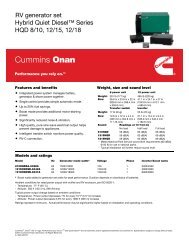Air Brake Manual
Air Brake Manual
Air Brake Manual
Create successful ePaper yourself
Turn your PDF publications into a flip-book with our unique Google optimized e-Paper software.
Axle<br />
Anti-lock <strong>Brake</strong> System (ABS)<br />
An anti-lock brake system is an electronic system<br />
that monitors wheel speed at all times and controls<br />
wheel speed while braking. If it detects a wheel<br />
locking-up during a brake application, the system<br />
releases brake pressure to that wheel only. This<br />
keeps the wheel from skidding and increases<br />
vehicle stability and control during emergency stops<br />
and in adverse situations such as on wet or ice<br />
slicked roads, through curves or during lane<br />
changes. The air brake system remains the same<br />
with the addition of the ABS components.<br />
An ABS basically consists of:<br />
· An electronic control unit (ECU)<br />
· A wheel sensor and tooth wheel<br />
· ABS valves<br />
Tooth Wheel and Sensor Block<br />
Wheel<br />
The ECU is the brain of the system. The wheel sensors<br />
are located on a minimum of two, or up to all six sets<br />
of wheels, depending on the system. The wheel<br />
sensors constantly send information to the ECU. When<br />
a brake application is made and the system detects a<br />
wheel locking-up, the ECU sends a message to the<br />
ABS valves to release brake pressure on that<br />
particular wheel preventing lockup. Usually there is a<br />
warning light located on the dash to inform the driver<br />
of the system operation. Every driver should have full<br />
understanding of the warning light operation for the<br />
vehicle they drive.<br />
When driving a vehicle with ABS apply the brakes<br />
normally. When the ABS starts working, do not release<br />
the pressure you have applied to the brake pedal.<br />
Avoid pumping the brake pedal as the ABS<br />
automatically applies and releases the brakes up to<br />
five times a second which is much faster than you can<br />
pump the brake pedal. For optimum ABS operation, the<br />
driver should make a brake application and hold,<br />
allowing the ABS to control braking pressure at each<br />
wheel.<br />
When using an engine brake and you encounter a<br />
slippery road surface, the ABS will detect the wheel<br />
lockup and automatically turn off the engine brake<br />
until traction is regained, then resume engine braking.<br />
For information specific to the vehicle you drive, refer<br />
to the operator’s manual.<br />
Trailers may also be equipped with ABS and the<br />
system will operate much the same as on the tractor.<br />
However, trailers with ABS will have a system warning<br />
light typically mounted on the trailer’s left front corner,<br />
visible in the left side mirror. On some systems they<br />
may have an extra warning light on the dash of the<br />
tractor.<br />
Tractors and trailers with or without ABS can be<br />
connected to one another without affecting the<br />
operation of the ABS.<br />
62




